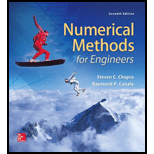
Concept explainers
Figure P8.44 shows three reservoirs connected by circular pipes. The pipes, which are made of asphalt-dipped cast iron
| Pipe | 1 | 2 | 3 |
| Length, m | 1800 | 500 | 1400 |
| Diameter, m | 0.4 | 0.25 | 0.2 |
| Flow,
|
|
0.1 | ? |
If the water surface elevations in Reservoirs A and C are 200 and 172.5 m, respectively, determine the elevation in Reservoir B and the flows in pipes 1 and 3. Note that the kinematic viscosity of water is

FIGURE P8.44
To calculate: The elevation in reservoir B and the flow in pipe 1 and pipe 3 in Figure P8.44, if the surface of water elevations in Reservoirs A is
Answer to Problem 44P
Solution:
The elevation in reservoir B is
The flow in pipe 1 is
The flow in pipe 3 is
Explanation of Solution
Given Information:
The pipe material is asphalt-dipped cast iron whose
The characteristics of the pipeare,
| Pipe | 1 | 2 | 3 |
| Length, m | 1800 | 500 | 1400 |
| Diameter, m | 0.4 | 0.25 | 0.2 |
| Flow, |
? | 0.1 | ? |
The surface of water elevations in Reservoirs A is
The kinematic viscosity of water is
To determine the friction factor, use the Colebrook equation (recall the Prob. 8.13).
Formula Used:
Write the Colebrook Equation to calculate the friction factor
Here,
Write the Blasius formula to find an initial approximation of the friction factor,
Write the Newton Raphson formula.
Write the expression for pressure drop in the section Pipe
Here,
Write the expression for the pressure.
Here,
Calculation:
Recall the characteristics of pipe,
| Pipe | 1 | 2 | 3 |
| Length, m | 1800 | 500 | 1400 |
| Diameter, m | 0.4 | 0.25 | 0.2 |
| Flow, |
? | 0.1 | ? |
Recall the Colebrook Equation.
Rearrange the Colebrook Equation for root location.
Here, Roughness is
Diameter is
Re is the Reynolds number
At initial approximation for Re is taken to be
Substitute all the above value in Colebrook Equation.
Calculate an initial approximation of the friction factor.
Recall the Blasius formula.
The initial estimation of Reynolds number is
Use the Newton Raphson method to find the root of the equation (2).
The function is as follows,
Take the first derivative.
Recall the Newton Raphson formula.
The iterations are shown below:
The root of the Equation occurs at
Calculate the pressure drop in the section Pipe 1.
Recall the expression for pressure drop in the section Pipe.
And the expression for the velocity of the circular pipe is,
Substitute
Now for pipe 1,
The frictional factor is
The length of the pipe is
Density is
Diameter is
Substitute all the value.
Rearrange for
Calculate the water pressure.
Write the expression for the water pressure.
The density of water is
And, this is equal to
Substitute
Therefore, the flow rate of pipe 1 is
Calculate the flow rate for the Pipe 3.
Substitution the roughness is
Calculate an initial approximation of the friction factor.
Recall the Blasius formula.
The initial estimation of Reynolds number is
Use the Newton Raphson method to find the root of the equation (4).
Write the function as follows,
Take the first derivative,
The iterations are shown below:
The root of the Equation occurs at
Calculate the pressure drop in the section Pipe 3.
Recall the expression for pressure drop in the section Pipe.
And the expression for the velocity of the circular pipe is,
Substitute
Now for pipe 3,
The frictional factor is
The length of the pipe is
Density is
Diameter is
Substitute all the value.
Rearrange for
The formula for water pressure is:
The density of water is
And, this is equal to
Substitute
Therefore, the flow rate of pipe 3 is
For Pipe 2,
Write the Colebrook Equation for root location from equation (1).
The roughness is
Substitution of the above parameters gives the following equation,
Calculate an initial approximation of the friction factor.
Recall the Blasius formula.
The initial estimation of Reynolds number is
The Newton Raphson formula is,
Use the Newton Raphson method to find the root of the equation (7).
Write the function as follows,
Take the first derivative,
The iterations are shown below:
The root of the Equation occurs at
Calculate the pressure drop in the section Pipe 2.
Recall the expression for pressure drop in the section Pipe.
And the expression for the velocity of the circular pipe is,
Substitute
Now for pipe 2,
The frictional factor is
The length of the pipe is
Density is
Diameter is
Substitute all the above value.
Now, this pressure drop in a section of Pipe 2 is equivalent to the water pressure from reservoir 2.
The formula for water pressure is,
Here, the density of water is
And, this is equal to
Substitute
Therefore, the elevation in reservoir B is
Want to see more full solutions like this?
Chapter 8 Solutions
Numerical Methods for Engineers
Additional Math Textbook Solutions
Fundamentals of Differential Equations (9th Edition)
Advanced Engineering Mathematics
Basic Technical Mathematics
High School Math 2012 Common-core Algebra 1 Practice And Problem Solvingworkbook Grade 8/9
Introductory Statistics (2nd Edition)
- A stamped sheet steel plate is shown in Figure 164. Compute dimensions AF to 3 decimal places. All dimensions are in inches. A=_B=_C=_D=_E=_F=_arrow_forwardRefer to Figure 29-9 to determine the values in the table. Allowance is equal to the maximum interference. All dimensions are in millimetersarrow_forward
 Mathematics For Machine TechnologyAdvanced MathISBN:9781337798310Author:Peterson, John.Publisher:Cengage Learning,
Mathematics For Machine TechnologyAdvanced MathISBN:9781337798310Author:Peterson, John.Publisher:Cengage Learning,
